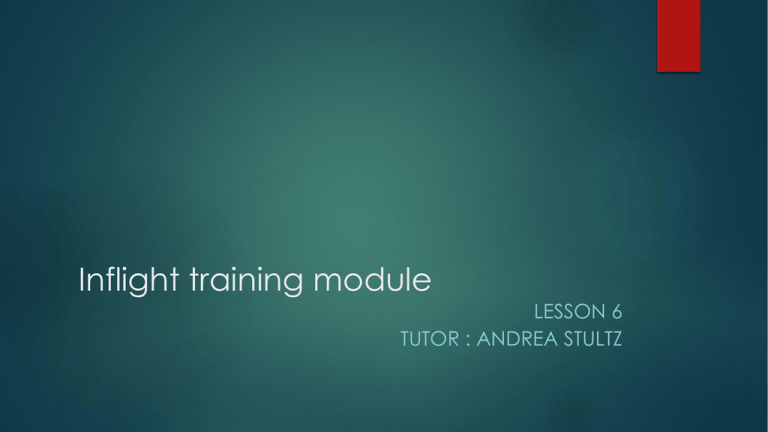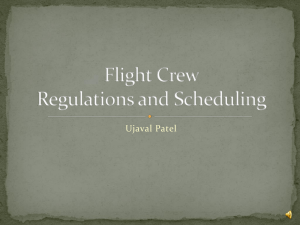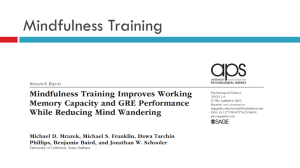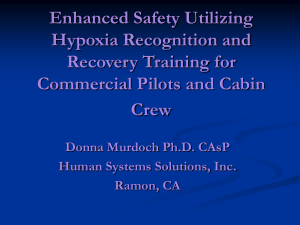Learning outcome : lesson 6 tutor : Andrea
advertisement

Inflight training module
LESSON 6
TUTOR : ANDREA STULTZ
Learning Outcomes
OUTLINE THE KEY POINTS OF THE LEGISLATION RELATING TO AVIATION
SECURITY
DESCRIBE SECURITY MEASURES TAKEN PRE-FLIGHT, INFLIGHT AND POST
FLIGHT
IDENTIFY RESTRICTED ARTICLES AND DANGEROUS ITEMS
DESCRIBE TYPES OF THREAT THAT RELATE TO THE AVIATION INDUSTRY
EXPLAIN THE PROCEDURES FOR DEALING WITH ONBOARD SECURITY
INCIDENTS
EXPLAIN THE IMPORTANCE OF CHECKING PASSENGER BOARDING CARDS IN
RELATION TO SECURITY
PERFORM A SAFETY DEMONSTRATION
CARRY OUT CABIN SECURE CHECKS
LEGISLATION RELATING TO AIRLINE SECURITY
AVIATION LAW IS THE BRANCH OF LAW THAT CONCERNS FLIGHT, AIR
TRAVEL, AND ASSOCIATED LEGAL AND BUSINESS CONCERNS.
AVIATION LAW IS CONSIDERED A MATTER OF INTERNATIONAL LAW DUE
TO THE NATURE OF AIR TRAVEL. HOWEVER, THE BUSINESS ASPECTS OF
AIRLINES AND THEIR REGULATION ALSO FALL UNDER AVIATION LAW.
IN THE UNITED STATES, THE FEDERAL AVIATION ADMINISTRATION (FAA)
GOVERNS APPLIED ASPECTS OF FLIGHT. IN THE INTERNATIONAL REALM,
THE INTERNATIONAL CIVIL AVIATION ORGANIZATION (ICAO) PROVIDES
GENERAL RULES AND MEDIATES INTERNATIONAL CONCERNS TO AN
EXTENT REGARDING AVIATION LAW. THE ICAO IS A SPECIALIZED
AGENCY OF THE UNITED NATIONS.
FEDERAL AVIATION ADMINISTRATION
{FAA}
THE FEDERAL AVIATION ADMINISTRATION (FAA) IS THE NATIONAL
AVIATION AUTHORITY OF THE UNITED STATES. AN AGENCY OF
THE UNITED STATES DEPARTMENT OF TRANSPORTATION, IT HAS
AUTHORITY TO REGULATE AND OVERSEE ALL ASPECTS OF
AMERICAN CIVIL AVIATION. THE FEDERAL AVIATION ACT OF
1958 CREATED THE ORGANIZATION UNDER THE NAME FEDERAL
AVIATION AGENCY. THE AGENCY ADOPTED ITS CURRENT NAME IN
1966 WHEN IT BECAME A PART OF THE U.S. DEPARTMENT OF
TRANSPORTATION.
Security Measures taken pre-flight,
inflight and post flight
PREFLIGHT SECURITY MEASURES
SECURITY IS ONE OF THE MAJOR FACTORS ALL CABIN CREW HAVE TO
TAKE VERY SERIOUSLY ON A DAILY BASIS. OUR RESPONSIBILITY IS NOT
ONLY TO KEEP OURSELVES SAFE, BUT WE ARE ALSO RESPONSIBLE FOR
THE WELFARE OF THE PASSENGERS AND THE SAFETY OF THE AIRCRAFT
AND CREW.
THE KEY IS ALWAYS PREVENTION AND YOU SHOULD ALWAYS REMAIN
‘AWARE’ OF POTENTIAL THREATS. THIS INCLUDES SERIOUS INCIDENTS
SUCH AS BOMB THREATS AND HIJACKING BUT ALSO UNRULY
PASSENGERS AND PERSONAL SAFETY AS WELL.
Cabin Crew must constantly monitor and maintain the security of the passengers
and the aircraft. This will be done pre-flight, during flight and post flight through
following the required procedures and checks that we must complete every
single flight. This includes security checks of the galley, cabin, safety equipment,
crew seat, crew rest area and lavatories.
Vigilance is very important at all times, as a potential threat can occur at any
moment, whether it is someone acting strangely or aggressively or finding a
suspicious item or note. There are many other procedures and checks that take
place during the flight.
Reporting any suspicious items, persons or strange behaviour is crucial to our
security and safety and a crew member should never be scared to do so. Always
report anything that may be a threat to the Senior Crew Member and the
Captain (depending on potential severity), who will be able to assess the threat
and advise and act accordingly.
Safety and security are non-negotiable and you should never be complacent
and think ‘it won’t happen to me’. Remember that vigilance and prevention are
key and all cabin crew should be able to identify potential threats, report it and
then follow the airlines procedures to deal with it. That innocent looking duty free
bag in the overhead locker might have been left by a passenger by mistake
but…it is better to be safe than sorry!
PRE-DEPARTURE CHECKS ON BOARD THE AIRCRAFT:
ENSURE ALL EQUIPMENT ARE ON BOARD E.G. LIFE VESTS, FLASHLIGHTS,
FIREFIGHTING AND FIRST AID EQUIPMENT. THESE SHOULD BE IN THE CORRECT
QUANTITY AND IN PROPER CONDITION.
UNSERVICEABLE /MISSING ITEMS REPORTED AND RECTIFIED BEFORE TAKEOFF
MONITOR CABIN FOR ANY UNUSUAL SMELL / UNUSUAL SITUATIONS
MAINTAIN CERTAIN PRECAUTIONS – DOORS DISARMED/OPEN DURING
FUELLING ON THE GROUND.
ASSIST LOADING OF CARRY-ON BAGGAGE, CHECK WEIGHT, SIZE AND
DANGEROUS GOODS. SAFETY DEMONSTRATION – LIVE/ VIDEO
ENSURE TRAY TABLES ARE PROPERLY STORED, SEATS UPRIGHT, ARMRESTS
DOWN AND SEATBELTS FASTENED PRIOR TO TAKE-OFF.
AFTER TAKE-OFF:
CABIN CHECKS EVERY 20-30 MINS ESPECIALLY DURING THE NIGHT.
THEY LISTEN FOR UNUSUAL NOISES OR SITUATIONS.
CHECK LAVARATORY, ENSURE SMOKE DETECTORS ARE ACTIVE, PAX SAFE IN
LAVARATORY AND THAT THERE IS NO SMOKING.
REGULAR CHECKS MUST BE MADE ON THE COCKPIT TO ENSURE PILOTS
SAFETY AND HEALTH.
THEY ARE REQUIRED TO RESPOND IMMEDIATELY TO CALL LIGHTS, DEAL WITH
SPECIAL PAX REQUESTS AND SMALLER EMERGENCIES THAT MAY OCCUR
FROM TIME TO TIME.
PRIOR TO LANDING:
COLLECT AND SECURE ALL LOOSE ITEMS, TRAYS, DISPOSE OF HOT LIQUIDS
AND GARBAGE MUST BE COLLECTED AND SECURED ALONG WITH SERVICE
AND GALLEY EQUIPMENT.
BE ALWAYS AWARE OF MECHANICAL EMERGENCIES THAT CAN OCCUR
DURING TAKE-OFF AND LANDING.
IDENTIFY RESTRICTED ARTICLES AND
DANGEROUS ITEMS
WHAT ARE DANGEROUS GOODS?
MANY ITEMS WHICH MIGHT APPEAR TO BE HARMLESS IN EVERYDAY USE
CAN POSE DANGERS WHENEVER THEY ARE CARRIED ON AN AIRCRAFT
AND ARE CONSEQUENTLY FORBIDDEN FOR CARRIAGE BY PASSENGERS
EITHER IN THE CABIN OR IN THEIR CHECKED BAGGAGE
THERE ARE A NUMBER OF ITEMS INCLUDING WEAPONS, THAT ARE PROHIBITED FROM
BEING CARRIED IN THE CABIN OF AN AIRCRAFT.
SOME OF THESE ARE :
KNIVES
GUNS AND AMMUNITION INCLUDING TOYS AND REPLICAS
EXPLOSIVES
SCISSORS
TOOLS SUCH AS CHISELS, KNITTING NEEDLES, CROCHET NEEDLES
CORK SCREWS WITH SHARP POINTS
CROSS BOWS AND SPEAR GUNS
SPORTING GOODS THAT COULD BE USED TO HARM INCLUDING BATS, STICKS,
POLES, RODS AND SPIKES
Civil Aviation Regulations on
Dangerous Goods
THE CAA HAS FOUR AUTHORISED INSPECTORS WHO CHECK THAT THE INDUSTRY IS
COMPLYING WITH ALL REGULATIONS AND REQUIREMENTS RELATING TO DANGEROUS
GOODS.
AUDIT STYLE INSPECTIONS ARE CARRIED OUT ON AIRCRAFT OPERATORS WHO HAVE
APPROVAL TO CARRY DANGEROUS GOODS AS CARGO AND THEIR HANDLING
AGENTS (PASSENGER AND CARGO) WITH A VIEW TO ASSESSING WHETHER
ADEQUATE PROCEDURES AND TRAINING ARE IN PLACE.
THE INSPECTORS ALSO CARRY OUT INSPECTIONS IN FREIGHT SHEDS AND
WAREHOUSES, ON THE RAMP AND IN AIRPORT TERMINALS TO CHECK ON:
PACKAGES AND DOCUMENTS,
PROCEDURES FOR HANDLING DANGEROUS GOODS,
THE QUALITY OF STAFF TRAINING
THE PROVISION OF ADEQUATE NOTICES AT CARGO ACCEPTANCE POINTS AND
PASSENGER CHECK-IN AREAS
Case Study for Dangerous Goods
Flight 592 pushed back from the gate in Miami, Florida on the afternoon of May 11, 1996. They had
just experienced a delay of 1 hour and 4 minutes due to mechanical problems.
[There
were 105 passengers on board, as well as a crew of two pilots and three flight attendants. The
total number of people on board was 110. At 2:04 pm, 10 minutes before the disaster, the DC-9 took
off from runway 9L and began a normal climb.
At 2:10 pm :
The passengers started to smell smoke. Flight Attendant tried to reassure passengers that
everything was going to be ok.
The temperatures were rising and the smoke was getting thicker. The pilots heard a loud bang in
their headphones and noticed the plane was losing electrical power. The spike in electrical
power and the bang were eventually determined to be the result of a tire in the cargo hold
exploding.
Seconds later the flight attendant entered the cockpit and informed the flight crew of a fire in the
passenger cabin.
Passengers' shouts of "fire, fire, fire" were recorded on the cockpit voice recorder when the cockpit
door was opened. Though the ValuJet flight attendant manual stated that the cockpit door should
not be opened when smoke or other harmful gases might be present in the cabin, the intercom was
disabled and there was no other way to inform the pilots of what was happening.
The CDR indicated a progressive failure of the electrical and flight control
systems due to the spreading fire.
The cockpit crew immediately asked air traffic control for a return to Miami due
to the increasing smoke in the cockpit and cabin, instructions were given for a
return to the airport. One minute later, the Captain requested the nearest
available airport. The Captain began to turn the plane left in preparation for the
return to Miami. At that time flight attendant J entered the cockpit wanting to
know why the pilots didn't lower the oxygen masks for the passengers. Flight 592
disappeared from radar at 2:13:42 pm. Eyewitnesses nearby watched as the
plane banked sharply to the left, rolled onto its side and nosedived into the
Francis S. Taylor Wildlife Management Area in the Everglades, a few miles west
of Miami, at a speed in excess of 507 miles per hour (816 km/h). The captain lost
control of the plane less than 10 seconds prior to impact. The crew, possibly had
also become incapacitated by smoke and fumes. As power had been lost to
the cockpit voice recorder about 55 seconds prior to impact, it was impossible
to determine with certainty.[1]
The cockpit crew, the three flight attendants, and all 105 passengers
aboard were killed instantly. Recovery of the aircraft and victims
was extremely difficult because of the location of the crash. The
DC-9 was destroyed on impact, with no large pieces of the fuselage
remaining.
QUESTION
Based on your previous knowledge give an overview of the
happenings that led to this disaster and state what and where the
breakdown started and how this disaster could have been
prevented.
THE IMPORTANCE OF CHECKING
PASSENGER BOARDING CARDS IN
RELATION TO SECURITY
Gives a passenger permission to board the airplane for a particular flight.
Identifies the passenger, flight number, and the date and scheduled time
for departure.
Ensures passengers are on the correct flight
Ensures passes are what are issued by the airline
Ensures passes are real and not fake
Helps you to access your passengers
Inflight safety demonstration
REFERENCES
Air Crash Investigation: ValuJet Flight 592 ''Florida Swamp Air Crash'' - YouTube. 2014. Air
Crash Investigation: ValuJet Flight 592 ''Florida Swamp Air Crash'' - YouTube. [ONLINE]
Available at:https://www.youtube.com/watch?v=-WoA2GgHntA. [Accessed 21 October
2014].
Airline Operations 11: Inflight Module “A Warm Welcome on Board.”
IAOT - In-Flight Safety Demonstration - YouTube. 2014. IAOT - In-Flight Safety Demonstration
- YouTube. [ONLINE] Available at: https://www.youtube.com/watch?v=AtMzngYdx4s
[Accessed 21 October 2014].
The importance of security procedures — CabinCrew.com . 2014. The importance of
security procedures — CabinCrew.com . [ONLINE] Available
at: http://www.cabincrew.com/career-advice/the-importance-of-securityprocedures/1130. [Accessed 21 October 2014].






